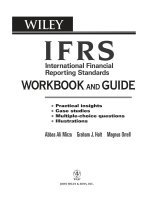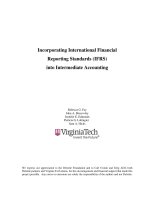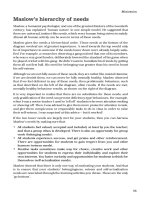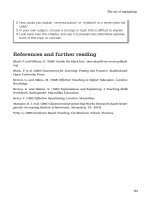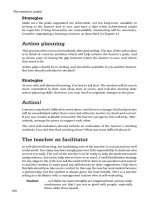international financial reporting standards a practical guide 6th edition
Bạn đang xem bản rút gọn của tài liệu. Xem và tải ngay bản đầy đủ của tài liệu tại đây (3.4 MB, 452 trang )
Public Disclosure Authorized
60807
Public Disclosure Authorized
Covers all
IASB standards
through
September 2010
INTERNATIONAL
FINANCIAL
REPORTING STANDARDS
A PRACTICAL GUIDE
Public Disclosure Authorized
Public Disclosure Authorized
SIXTH EDITION
HENNIE VAN GREUNING
DARREL SCOTT
SIMONET TERBLANCHE
International Financial
Reporting Standards
A Practical Guide
International Financial
Reporting Standards
A Practical Guide
Sixth Edition
Hennie van Greuning
Darrel Scott
Simonet Terblanche
THE WORLD BANK
Washington, D.C.
© 2011 The International Bank for Reconstruction and Development / The World Bank
1818 H Street NW
Washington DC 20433
Telephone: 202-473-1000
Internet: www.worldbank.org
All rights reserved
1 2 3 4 :: 14 13 12 11
The findings, interpretations, and conclusions expressed in this volume are those of the
authors and do not necessarily reflect the views of the Executive Directors of The World Bank
or the governments they represent.
The World Bank does not guarantee the accuracy of the data included in this work. The
boundaries, colors, denominations, and other information shown on any map in this work do
not imply any judgement on the part of The World Bank concerning the legal status of any
territory or the endorsement or acceptance of such boundaries.
Rights and Permissions
The material in this publication is copyrighted. Copying and/or transmitting portions or all
of this work without permission may be a violation of applicable law. The International Bank
for Reconstruction and Development / The World Bank encourages dissemination of its work
and will normally grant permission to reproduce portions of the work promptly.
For permission to photocopy or reprint any part of this work, please send a request with
complete information to the Copyright Clearance Center Inc., 222 Rosewood Drive, Danvers,
MA 01923, USA; telephone: 978-750-8400; fax: 978-750-4470; Internet: www.copyright.com.
All other queries on rights and licenses, including subsidiary rights, should be addressed to
the Office of the Publisher, The World Bank, 1818 H Street NW, Washington, DC 20433, USA;
fax: 202-522-2422; e-mail:
ISBN: 978-0-8213-8428-2
eISBN: 978-0-8213-8555-5
DOI: 10.1596/978-0-8213-8428-2
Library of Congress Cataloging-in-Publication data has been requested.
Contents
Foreword: World Bank Treasury
Foreword: FirstRand Limited
Acknowledgments
Introduction
PART I
Chapter 1
2
3
4
5
INTRODUCTORY PRINCIPLES
Framework
IFRS 1
IAS 1
IAS 7
IAS 8
PART II
Chapter 6
7
8
9
Framework for the Preparation and Presentation of Financial Statements
First-Time Adoption of IFRS
Presentation of Financial Statements
Statement of Cash Flows
Accounting Policies, Changes in Accounting Estimates, and Errors
3
11
17
37
49
GROUP STATEMENTS
IFRS 3
IAS 27
IAS 28
IAS 31
PART III
Chapter 10
11
12
13
14
15
16
17
18
19
20
21
22
vii
viii
ix
xi
Business Combinations
Consolidated and Separate Financial Statements
Investments in Associates
Interests in Joint Ventures
59
79
91
99
STATEMENT OF FINANCIAL POSITION / BALANCE SHEET
IAS 16
IAS 40
IAS 41
IAS 38
IAS 17
IAS 12
IAS 2
IAS 39
IFRS 9
IFRS 5
IFRS 6
IAS 37
IAS 21
Property, Plant, and Equipment
Investment Property
Agriculture
Intangible Assets
Leases
Income Taxes
Inventories
Financial Instruments: Recognition and Measurement
Financial Instruments
Noncurrent Assets Held for Sale and Discontinued Operations
Exploration for and Evaluation of Mineral Resources
Provisions, Contingent Liabilities, and Contingent Assets
The Effects of Changes in Foreign Exchange Rates
109
123
131
143
151
169
183
193
217
223
231
239
247
v
vi
Contents
PART IV
STATEMENT OF COMPREHENSIVE INCOME /
INCOME STATEMENT
Chapter 23
24
25
26
27
28
IAS 18
IAS 11
IAS 19
IAS 36
IAS 23
IAS 20
29
IFRS 2
PART V
Chapter 30
31
32
33
34
35
36
37
38
39
Revenue
Construction Contracts
Employee Benefits
Impairment of Assets
Borrowing Costs
Accounting for Government Grants and Disclosure of Government
Assistance
Share-Based Payment
257
265
275
287
295
303
309
DISCLOSURE
IAS 10
IAS 24
IAS 33
IAS 32
IFRS 7
IFRS 8
IAS 34
IAS 26
IFRS 4
IAS 29
Events after the Reporting Period
Related-Party Disclosures
Earnings per Share
Financial Instruments: Presentation
Financial Instruments: Disclosures
Operating Segments
Interim Financial Reporting
Accounting and Reporting by Retirement Benefit Plans
Insurance Contracts
Financial Reporting in Hyperinflationary Economies
323
327
349
361
367
391
399
407
413
427
About the Contributors
433
Foreword: World Bank Treasury
The publication of this sixth edition follows fairly soon after the previous edition, as the convergence in accounting standards has accelerated, despite some significant challenges.
International convergence in accounting standards under the leadership of the International
Accounting Standards Board (IASB) and the Financial Accounting Standards Board (FASB)
in the United States has now progressed to the point where more than 100 countries currently
subscribe to the International Financial Reporting Standards (IFRS).
The rush toward convergence continues to produce a steady stream of revisions to accounting standards by both the IASB and FASB. For accountants, financial analysts, and other
specialists, there is already a burgeoning technical literature explaining in detail the background and intended application of these revisions. This book provides a nontechnical yet
comprehensive managerial overview of the underlying materials.
The appearance of this sixth edition—already translated into 15 languages in its earlier editions—is therefore timely. In this edition, the World Bank Treasury has partnered with a major
bank in a client country to co-author and co-produce the publication. It is a logical step for the
Bank to draw on the considerable technical expertise available from such a partner, and it
brings an additional practical dimension to this publication by emphasizing strategic and
tactical implementation decisions made by financial regulated-statement issuers. The book
already forms the basis of a securities accounting workshop offered several times each year to
World Bank Treasury clients in central banks and other public sector funds.
Each chapter briefly summarizes and explains a new or revised IFRS, the issue or issues the
standard addresses, the key underlying concepts, the appropriate accounting treatment, and the
associated requirements for presentation and disclosure. The text also covers financial analysis
and interpretation issues and a commentary on implementation decisions to better demonstrate
the potential effect of the accounting standards on business decisions. Simple examples in most
chapters help further clarify the material. It is our hope that this approach, in addition to providing a handy reference for practitioners, will help relieve some of the tension experienced by
nonspecialists when faced with business decisions influenced by the new rules.
Kenneth G. Lay, CFA
Treasurer
The World Bank
Washington, D.C.
December 2010
vii
Foreword: FirstRand Limited
FirstRand Limited is proud to be a co-sponsor of this publication together with the World
Bank Treasury. FirstRand is a large, publicly listed financial services group which operates
largely in South Africa and on the African continent. Our growth strategy increasingly
requires us to develop business opportunities presented by the investment and trade flows
resulting from trade corridors that are rapidly emerging between Africa, India, and China.
Given that the World Bank is also active in these territories, we believe it is extremely appropriate for us to be associated with such a prestigious development institution, particularly as
a key part of the World Bank’s mandate is to protect transparency for stakeholders and promote adherence to best practice. These principles are also integral to the way FirstRand aims
to communicate with its many stakeholders, who fully support our own strategic intent: to
be the African financial services group of choice, creating long-term franchise value and
delivering superior and sustainable economic returns to shareholders within acceptable
levels of volatility.
In addition to financial sponsorship, the chief financial officer of FirstRand’s banking businesses and a team of his staff members actively contributed to the publication by researching
and writing on the latest technical IFRS issues. This collaboration is an example of how
FirstRand seeks to uplift and empower our highly skilled employees and further demonstrates that our staff members are encouraged to improve their capabilities. Training and
education programs at FirstRand are regarded as an essential element of our investment in
human capital, and the content of these programs is based on needs identified from industry
trends, best practice, and research. Making a publication of this nature accessible to our
broader staff, to our clients, and to professionals and students in the areas where we operate
not only assists us in fulfilling our commitment to training and education, but also gives
members of our own staff an opportunity to contribute to the development of best practice
in accounting standards.
Sizwe Nxasana, CA(SA)
CEO
FirstRand Limited
Sandton, South Africa
December 2010
viii
Acknowledgments
The authors are grateful to Ken Lay, vice president and treasurer of the World Bank, who has
supported this sixth edition as a means to assist World Bank client countries with a publication to facilitate understanding the International Financial Reporting Standards (IFRS) and to
emphasize the importance of financial analysis and interpretation of the information produced through application of these standards.
Our gratitude also extends to the senior management of FirstRand Limited, who devoted
staff time and resources to co-produce this publication.
Colleagues in the World Bank Treasury shared their insights into the complexities of applying certain standards to the treasury environment. We benefited greatly from hours of conversation with many colleagues, including Hamish Flett and Richard Williams.
The contributing team from the technical accounting group at FirstRand Limited assisted
greatly in researching updates to IFRS. Without the assistance of the team members, this publication could not have succeeded.
Mark Ingebretsen from the World Bank’s Office of the Publisher remained patient and helpful throughout the production process. Thank you. Current and former members of the
publishing team have provided tremendous support through the various editions of this
book: thank you, Santiago Pombo, Stuart Tucker, Jose de Buerba, Mayya Revzina, and
Valentina Kalk.
Despite the extent and quality of the inputs that we have received, we are solely responsible
for the contents of this publication.
Hennie van Greuning
Darrel Scott
Simonet Terblanche
December 2010
ix
Introduction
This text, based on five earlier editions that have already been translated into 15 languages,
is an important contribution to expanding awareness and understanding of International
Financial Reporting Standards (IFRS) around the world, with easy-to-read summaries of each
standard and examples that illustrate accounting treatments and disclosure requirements.
TARGET AUDIENCE
A conscious decision has been made to focus on the needs of executives and financial analysts in the private and public sectors who might not have a strong accounting background.
This publication summarizes each standard, whether it is an IFRS or an International Accounting Standard, so managers and analysts can quickly obtain a broad overview of the key
issues. Detailed discussion of certain topics has been excluded to maintain the overall objective of providing a useful tool to managers and financial analysts.
In addition to the short summaries, most chapters contain basic examples that emphasize the
practical application of some key concepts in a particular standard. This text provides the
tools to enable an executive without a technical accounting background to (1) participate in
an informed manner in discussions relating to the appropriateness or application of a particular standard in a given situation, and (2) evaluate the effect that the application of the
principles of a given standard will have on the financial results and position of a division or
of an entire enterprise.
STRUCTURE OF THIS PUBLICATION
Each chapter follows a common outline to facilitate discussion of each standard:
1. Objective of Standard identifies the main objectives and the key issues of the standard.
2. Scope of the Standard identifies the specific transactions and events covered by a
standard. In certain instances, compliance with a standard is limited to a specified
range of enterprises.
3. Key Concepts explains the usage and implications of key concepts and definitions.
4. Accounting Treatment lists the specific accounting principles, bases, conventions, rules,
and practices that should be adopted by an enterprise for compliance with a particular
standard. Recognition (initial recording) and measurement (subsequent valuation) are
specifically dealt with, where appropriate.
xi
xii
Introduction
5. Presentation and Disclosure describes the manner in which the financial and nonfinancial items should be presented in the financial statements, as well as aspects
that should be disclosed in these financial statements—keeping in mind the needs of
various users. Users of financial statements include investors, employees, lenders,
suppliers or trade creditors, governments, tax and regulatory authorities, and the
public.
6. Financial Analysis and Interpretation discusses items of interest to the financial
analyst in chapters where such a discussion is deemed appropriate. None of the discussion in these sections should be interpreted as a criticism of IFRS. Where analytical
preferences and practices are highlighted, it is to alert the reader to the challenges still
remaining along the road to convergence of international accounting practices and
unequivocal adoption of IFRS.
7. A commentary discusses any debate surrounding a particular standard as well as
possible future developments or changes envisaged.
8. Implementation decisions related to strategic and tactical policy issues that might arise
are discussed in a separate section. No doubt users of this publication will be able to
add their own implementation problem points to the bullet points initiated in this new
section.
9. Examples included at the end of most chapters are intended as further illustration of
the concepts contained in the IFRS.
The authors hope that managers in the client private sector will find this format useful in
establishing accounting terminology, especially where certain terms are still in the exploratory stage in some countries.
CONTENT INCLUDED
All of the accounting standards issued by the International Accounting Standards Board
(IASB) through September 30, 2010, are included in this publication. The IASB texts are the
ultimate authority—this publication merely constitutes a summary.
Part I
Introductory
Principles
CHAPTER 1
Framework for the
Preparation and Presentation
of Financial Statements
1.1
OBJECTIVE
An acceptable coherent framework of fundamental accounting principles is essential for
preparing financial statements. The major reasons for providing the framework are to
■
■
■
■
■
identify the essential concepts underlying the preparation and presentation of financial
statements;
guide standard setters in developing new accounting standards and reviewing existing
standards;
assist preparers in preparing financial statements and dealing with topics that are not
covered by a specific IFRS;
assist auditors in forming an opinion as to whether a set of financial statements conforms with IFRS; and
assist users in interpreting the financial information contained in a set of financial statements that comply with IFRS.
The framework sets guidelines and should not be seen as a constitution; nothing in the
framework overrides any specific standard. However, because the standard setters are
guided by the framework when developing and reviewing specific standards, instances of
conflict between the framework and individual standards are not expected to be numerous
and are expected to diminish over time.
The framework may be revised over time based on the IASB’s experience of working with it.
1.2
SCOPE OF THE FRAMEWORK
The existing framework deals with the
■
■
■
■
■
■
objectives of financial statements;
qualitative characteristics of financial statements;
elements of financial statements;
recognition of the elements of financial statements;
measurement of the elements of financial statements; and
concepts of capital and capital maintenance.
3
4
1.3
Chapter 1 Framework for the Preparation and Presentation of Financial Statements
KEY CONCEPTS
Objective of Financial Statements
1.3.1 The objective of financial statements is to provide information about the financial
position (statement of financial position), performance (statement of comprehensive income), and changes in financial position (statement of cash flows) of an entity that is useful
to a wide range of users in making economic decisions. Users of financial information include present and potential capital providers, employees, lenders, suppliers, customers, and
the government.
1.3.2 Financial statements also show the results of management’s stewardship of the
resources entrusted to it. This information, along with other information in the notes to the
financial statements, provides users of financial statements with information about the amount,
timing, and uncertainty of the entity’s future cash flows in order that they can make economic
decisions. In order to meet this objective, financial statements contain information about
■
■
■
■
■
■
assets;
liabilities;
equity;
income and expenses, including gains and losses;
contributions by and distributions to owners in their capacity as owners; and
cash flows.
The following table sets out the assumptions underlying the preparation of financial statements, the qualitative characteristics of financial statements, and the constraints of providing
financial information.
Chapter 1 Framework for the Preparation and Presentation of Financial Statements
5
Fair presentation
The objective of financial statements is to achieve fair presentation.
Materiality
IFRS only applies to material information. An item is material if its omission or misstatement would change the decisions taken by the users of
the financial statements.
Underlying assumptions
Accrual basis of accounting
Financial statements are prepared based on the accrual basis of
accounting. Under this basis transactions are recorded when they
occur and not as the cash flows take place.
Going concern
Financial statements are prepared on the assumption that an entity is
a going concern and will be in operation for the foreseeable future.
Hence it is assumed that the entity has neither the intention nor the
need to liquidate or materially curtail the scale of its operations.
Qualitative characteristics
Understandability
Information should be readily understandable by users who have a basic knowledge of business, economic activities, and accounting, and who
have a willingness to study the information with reasonable diligence.
Relevance
Relevant information influences the economic decisions of users, helping them to evaluate past, present, and future events or to confirm or
correct their past evaluations. The relevance of information is affected by its nature and materiality. Information is considered to be material if
its omission or misstatement could influence the economic decisions of users taken on the basis of the financial statements.
Reliability
Reliable information is free from material error and bias and can be depended upon by users to represent faithfully that which it either purports to represent or could reasonably be expected to represent. The following factors contribute to reliability:
• faithful representation;
• substance over form;
• neutrality;
• prudence; and
• completeness.
Comparability
Information should be presented in a consistent manner over time and in a consistent manner between entities to enable users to make
significant comparisons.
Constraints on financial information
Timeliness
Undue delay in reporting could result in loss of relevance but
improve reliability. In achieving a balance between relevance and
reliability the overriding consideration is how best to satisfy the
economic decision-making needs of users.
Cost versus benefits
Benefits derived from information should exceed the cost of
providing it.
1.3.3 Balancing qualitative characteristics. To meet the objectives of financial statements and
make them adequate for a particular environment, providers of information must balance the
qualitative characteristics in such a way that best meets the objectives of financial statements.
1.3.4 The application of the principal qualitative characteristics and the appropriate accounting standards normally results in financial statements that provide fair presentation.
6
1.4
Chapter 1 Framework for the Preparation and Presentation of Financial Statements
ACCOUNTING TREATMENT
Elements of Financial Statements
1.4.1 The following elements of financial statements are directly related to the measurement
of the financial position:
■
■
■
Assets. Resources controlled by the entity as a result of past events and from which
future economic benefits are expected to flow to the entity.
Liabilities. Present obligations of an entity arising from past events, the settlement
of which is expected to result in an outflow from the entity of resources embodying
economic benefits.
Equity. The residual interest in the assets of an entity after deducting all of its liabilities
(may be referred to as shareholders’ funds).
1.4.2 The following elements of financial statements are directly related to the measurement
of performance:
■
■
Income. Increases in economic benefits during the accounting period in the form of
inflows or enhancements of assets, or decreases of liabilities that result in an increase in
equity (other than those relating to contributions from equity participants). Income
comprises both revenue and gains.
Expenses. Decreases in economic benefits during the accounting period in the form of
outflows or depletion of assets, or incurrences of liabilities that result in decreases in
equity, other than those relating to distributions to equity participants.
Initial Recognition of Elements
1.4.3 Recognition is the process of incorporating in the statement of financial position or
statement of comprehensive income an item that meets the definition of an element and satisfies the criteria for recognition. Elements (assets, liabilities, equity, income, and expenses)
should only be recognized in the financial statements if
■
■
it is probable that any future economic benefit associated with the item will flow to or
from the entity; and
the item has a cost or value that can be measured with reliability.
Subsequent Measurement of Elements
1.4.4 Measurement is the process of determining the monetary amounts at which the elements of the financial statements are to be recognized and carried in the statement of financial position and statement of comprehensive income. The following bases are used to different degrees and in varying combinations to measure elements of financial statements:
■
■
■
Historical cost. Assets are recorded at the amount paid or fair value of consideration
given to acquire them at the time of their acquisition. Liabilities are recorded at the
amount of proceeds received in exchange for the obligation.
Current cost. Assets are carried at the amount of cash and cash equivalents that would
have to be paid if the same or equivalent asset were acquired currently. Liabilities are
carried at the undiscounted amount of cash or cash equivalents that would be required
to settle the obligation currently.
Realizable (settlement) value. Assets are carried at the amount of cash and cash
equivalents that would be obtained by selling the assets in an orderly disposal. Liabilities are carried at their settlement values, that is, the undiscounted amount of cash or
cash equivalents expected to be paid to satisfy the liabilities in the normal course of
business.
Chapter 1 Framework for the Preparation and Presentation of Financial Statements
■
7
Present value assets are carried at the present discounted value of the future net cash
inflows that the item is expected to generate in the normal course of business. Liabilities are carried at the present discounted value of the future net cash outflows that are
expected to be required to settle the liabilities in the normal course of business.
Capital Maintenance Concepts
1.4.5 Capital and capital maintenance include
■
■
1.5
Financial capital is synonymous with net assets or equity; it is defined in terms of
nominal monetary units. Profit represents the increase in nominal money capital over
the period.
Physical capital is regarded as the operating capability; it is defined in terms of productive capacity. Profit represents the increase in productive capacity over the period.
PRESENTATION AND DISCLOSURE: TRANSPARENCY AND DATA QUALITY
1.5.1 In forming a safe environment for stakeholders, corporate governance rules should
focus on creating a culture of transparency. Transparency refers to making information on
existing conditions, decisions, and actions accessible, visible, and understandable to all market participants. Disclosure refers more specifically to the process and methodology of providing the information and of making policy decisions known through timely dissemination
and openness. Accountability refers to the need for market participants, including the relevant authorities, to justify their actions and policies and to accept responsibility for both
decisions and results.
1.5.2 Transparency is a prerequisite for accountability, especially to borrowers and lenders,
issuers and investors, national authorities, and international financial institutions. In part,
the case for greater transparency and accountability rests on the need for private sector
agents to understand and accept policy decisions that affect their behavior. Greater transparency improves economic decisions taken by other agents in the economy. Transparency also
fosters accountability, internal discipline, and better governance, while both transparency
and accountability improve the quality of decision making in policy-oriented institutions.
Such institutions—as well as other institutions that rely on them to make decisions—should
be required to maintain transparency. If actions and decisions are visible and understandable,
the costs of monitoring can be lowered. In addition, the general public is better able to
monitor public sector institutions, shareholders and employees have a better view of corporate management, creditors monitor borrowers more adequately, and depositors are able to
keep an eye on banks. Poor decisions do not go unnoticed or unquestioned.
1.5.3 Transparency and accountability are mutually reinforcing. Transparency enhances
accountability by facilitating monitoring, while accountability enhances transparency by
providing an incentive for agents to ensure that their actions are disseminated properly and
understood. Greater transparency reduces the tendency of markets to place undue emphasis
on positive or negative news and thus reduces volatility in financial markets. Taken together,
transparency and accountability also impose discipline that improves the quality of decision
making in the public sector. This can result in more efficient policies by improving the private
sector’s understanding of how policy makers may react to events in the future. Transparency
forces institutions to face up to the reality of a situation and makes officials more responsible,
especially if they know they will have to justify their views, decisions, and actions. For these
reasons, timely policy adjustment is encouraged.
1.5.4 The provision of transparent and useful information on market participants and their
transactions is an essential part of an orderly and efficient market; it also is a key prerequisite
8
Chapter 1 Framework for the Preparation and Presentation of Financial Statements
for imposing market discipline. For a risk-based approach to bank management and supervision to be effective, useful information must be provided to each key player: supervisors,
current and prospective shareholders and bondholders, depositors and other creditors, correspondent and other banks, counterparties, and the general public. Left alone, markets may
not generate sufficient levels of disclosure. Although market forces normally balance the
marginal benefits and costs of disclosing additional information, the end result may not be
what players really need.
1.5.5 The public disclosure of information is predicated on the existence of quality accounting standards and adequate disclosure methodology. The process normally involves publication of relevant qualitative and quantitative information in annual financial reports, which
are often supplemented by biannual or quarterly financial statements and other important
information. Because the provision of information can be expensive, disclosure requirements
should weigh the usefulness of information for the public against the costs of providing it.
1.5.6 It is also important to time the introduction of information well. Disclosure of negative
information to a public that is not sufficiently sophisticated to interpret it could damage an
entity (especially if it is a financial institution). In situations where low-quality information
is put forth or users are not deemed capable of properly interpreting what is disclosed, public requirements should be phased in carefully and tightened progressively. In the long run,
a full-disclosure regime is beneficial, even if some immediate problems are experienced,
because the cost to the financial system of not being transparent is ultimately higher than the
cost of revealing information.
1.5.7 The financial and capital market liberalization of the past decades brought increasing
volatility to financial markets and, consequently, increased the information needed to ensure
financial stability. With the advance of financial and capital market liberalization, pressure
has increased to improve the usefulness of available financial sector information through the
formulation of minimum disclosure requirements. These requirements address the quality
and quantity of information that must be provided to market participants and the general
public.
1.5.8 Transparency and accountability are not ends in and of themselves; nor are they
panaceas to solve all problems. They are designed to improve economic performance and the
working of international financial markets by enhancing the quality of decision making and
risk management among market participants. In particular, transparency does not change the
nature of banking or the risks inherent in financial systems. Although it cannot prevent financial crises, transparency may moderate the responses of market participants to bad news by
helping them to anticipate and assess negative information. In this way, transparency helps
to mitigate panic and contagion.
1.5.9 A dichotomy exists between transparency and confidentiality. The release of proprietary information may enable competitors to take advantage of a particular situation, a fact
that often deters market participants from full disclosure. Similarly, monitoring bodies frequently obtain confidential information from financial institutions, which can have significant market implications. Under such circumstances, financial institutions may be reluctant
to provide sensitive information without the guarantee of client confidentiality. However,
both unilateral transparency and full disclosure contribute to a regime of transparency. If
such a regime were to become the norm, it would ultimately benefit all market participants,
even if in the short term it would create discomfort for individual entities.
1.5.10 In the context of public disclosure, financial statements should be easy to interpret.
Widely available and affordable financial information supports official and private monitor-
Chapter 1 Framework for the Preparation and Presentation of Financial Statements
9
ing of a business’s financial performance. It promotes transparency and supports market
discipline, two important ingredients of sound corporate governance. Besides being a goal
in itself, in that it empowers stakeholders, disclosure could be a means to achieve better
governance. The adoption of internationally accepted financial reporting standards is a necessary measure to facilitate transparency and contribute to proper interpretation of financial
statements.
1.5.11 In the context of fair presentation, no disclosure is probably better than disclosure
of misleading information.
1.6
COMMENTARY
1.6.1 The framework provides robust descriptions and guidance about the concepts underlying current accounting practices. The current framework was published for the first time
in July 1989 by the IASB’s predecessor body, IASC, and was adopted by the IASB in 2001.
Many of the definitions and concepts in the current framework are therefore outdated and
are not as useful in the modern business world as they might have been historically. For
example, the current framework does not identify fair value as a possible measurement
base. Although current cost or present value may be close to what we understand fair value
to be today, they are not fair value. In the current environment the IASB is moving more and
more towards fair value measurement for items recognized in the financial statements, particularly financial instruments. Another example is that equity does not have its own definition, but rather is based on the definition of assets and liabilities. This makes the distinction
between equity instruments and financial liabilities in terms of IAS 32 very difficult in complex transactions.
1.6.2 Based on the shortcomings identified above as well as the fact that the framework
used to develop IFRS was not aligned to the framework to develop U.S. Generally Accepted
Accounting Principles (GAAP), the IASB and the FASB added a project to their agenda in
2004 to update the framework. The project was split into a number of phases with the IASB
taking the lead in developing certain phases and the FASB others. The IASB and FASB have
agreed to issue each phase as a separate document as they are finalized. When all phases
have been finalized they will be consolidated into a single conceptual framework.
1.6.3 The table below sets out the various phases of framework development, which standard setting body is leading the development of the phase, and the progress to date:
Phase
Standard setter responsible
Status
Objectives and qualitative
characteristics
IASB
The final chapter is expected to be published in the
near future.
Elements and recognition
FASB
Listed on the joint FASB/IASB current technical plan
and project updates for 2011.
Measurement
FASB
Listed on the joint FASB/IASB current technical plan
and project updates for 2011.
Reporting entity
IASB
Listed on the joint FASB/IASB current technical plan
and project updates for 2011.
10
Chapter 1 Framework for the Preparation and Presentation of Financial Statements
EXAMPLE: FRAMEWORK FOR THE PREPARATION AND PRESENTATION
OF FINANCIAL STATEMENTS
EXAMPLE 1.1
Chemco Inc. produces chemical products and sells them locally. The corporation wishes to
extend its market and export some of its products. The financial director realizes that compliance with international environmental requirements is a significant precondition if the company wishes to sell products overseas. Although Chemco already has established a series of
environmental policies, common practice expects an environmental audit to be done from time
to time, which will cost approximately $120,000. The audit would encompass the following:
■
■
■
a full review of all environmental policy directives;
a detailed analysis of compliance with these directives; and
a report containing in-depth recommendations of those physical and policy changes that
would be necessary to meet international requirements.
The financial director of Chemco has suggested that the $120,000 be capitalized as an asset
and then written off against the revenues generated from export activities so that the matching of income and expenses will occur.
EXPLANATION
The costs associated with the environmental audit can be capitalized only if they meet the
definition and recognition criteria for an asset. The IASB’s framework does not allow the
recognition of items in the statement of financial position that do not meet the definition or
recognition criteria.
To recognize the costs of the audit as an asset, it should meet both the
■
■
definition of an asset; and
recognition criteria for an asset.
For the costs associated with the environmental audit to comply with the definition of an
asset, the following should be valid:
i)
The costs must give rise to a resource controlled by Chemco.
ii) The asset must arise from a past transaction or event, namely the audit.
iii) The asset must be expected to give rise to a probable future economic benefit that will
flow to the corporation, namely the revenue from export sales.
The requirements of (i) and (iii) are not met. Therefore, Chemco cannot capitalize the costs of
the audit because of the absence of fixed orders and detailed analyses of expected economic
benefits.
To recognize the costs as an asset in the statement of financial postion, they must comply
with the recognition criteria (see §1.4.3), namely
■
■
The asset should have a cost that can be measured reliably.
The expected inflow of future economic benefits must be probable.
To properly measure the carrying value of the asset, the corporation must be able to demonstrate that further costs will be incurred that would give rise to future benefits. However, the
second requirement poses a problem because of insufficient evidence of the probable inflow of
economic benefits and would therefore again disqualify the costs for capitalizing as an asset.
CHAPTER 2
First-Time Adoption of IFRS
(IFRS 1)
2.1
OBJECTIVE
IFRS 1 provides entities with guidance on the process to be followed when adopting IFRS.
The purpose of IFRS 1 is to ensure that the entity’s first financial statements (including interim financial reports for that specific reporting period) under IFRS contain high-quality
information that is transparent and comparable over all periods presented; that provides a
suitable starting point for IFRS presentation; and can be generated at a cost that does not
exceed the benefits.
2.2
SCOPE OF THE STANDARD
IFRS 1 applies when an entity adopts IFRS for the first time by an explicit and unreserved
statement of compliance with IFRS. The standard specifically covers
■
■
■
■
comparable (prior period) information that is to be provided;
identification of the basis of reporting;
retrospective application of IFRS information; and
formal identification of the reporting and the transition date.
IFRS requires an entity to comply with each individual standard effective at the reporting
date for its first IFRS-compliant financial statements. Subject to certain exceptions and
exemptions, IFRS should be applied retrospectively. Therefore, the comparative amounts,
including the opening Statement of Financial Position for the comparative period, should be
restated from national generally accepted accounting principles (GAAP) to IFRS.
IFRS 1 does not apply to an entity already applying IFRS changes its accounting policies.
Changes in accounting policies for entities that already apply IFRS are treated in terms of
International Accounting Standard 8 (IAS 8) or in terms of the transitional provisions of a
specific standard.
11
